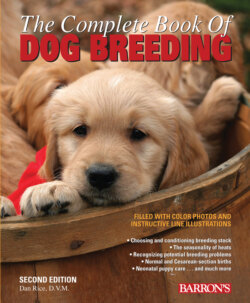Читать книгу The Complete Book of Dog Breeding - Dan Rice - Страница 15
На сайте Литреса книга снята с продажи.
Estrus
ОглавлениеThe next phase of the reproductive cycle is termed estrus. It corresponds to the stage often referred to as “standing heat,” when bitches will stand for breeding. It lasts from extremes of two to 21 days, more typically six to ten days, and averages nine days. It is during estrus that a bitch will mate with a male; spontaneous ovulation takes place during this phase.
Variations in females’ standing heat behavior may be due to hormonal changes in progesterone-estrogen ratios. Another equally important consideration that all breeders must acknowledge is female discretion. Studies have repeatedly shown that females’ breeding behavior can sometimes be changed simply by changing available mates (see Chapter 4 for more on this subject).
A vaginal discharge normally persists throughout the estrus period, but it changes from the usual bloody red of proestrus to a light pink or straw color as ovulation time nears. During estrus, most bitches will flirt with males by backing up to them, flagging their tails in the males’ faces, urinating frequently, and generally acting seductive. Females will sometimes mount available males and simulate copulation.
Estrogen hormone levels remain about the same, and progesterone levels begin to rise during estrus. Bitches become receptive to males as a result of interaction between estrogen and progesterone. Standing heat lasts several days, sometimes a week. After the first day on which a bitch will receive a male, estrogen levels drop and progesterone levels increase greatly.
Another measurable hormone should be mentioned. It is called lutenizing hormone (LH) and it originates from the pituitary gland. LH levels peak in the female’s bloodstream at the time she will first stand for a male. It has been determined that ovulation (release of eggs from ovarian follicles) occurs one to three days after the LH peak. In certain problem breeders, this information is of critical importance (see Chapter 4, Potential Breeding Problems).
